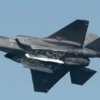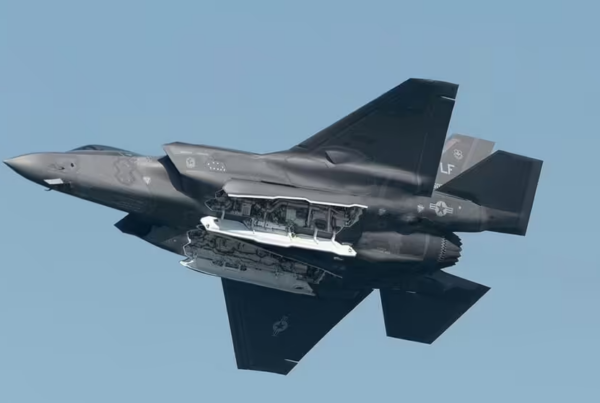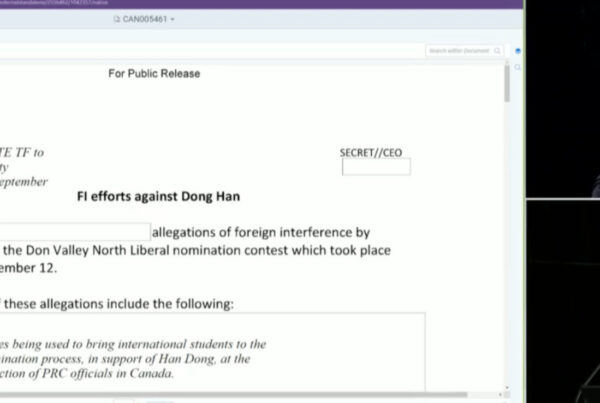Below is Part Two of a two-part series detailing the history of Canadian procurement practices, Canada’s role in the Joint Strike Fighter Program, and the government’s procurement process of the F-35 fighter.
The primary objective of any government is to protect its citizens. The means by which security is organized is a matter of subjective debate, yet the modern nation-state’s responsibility in upholding a social contract of security is non-negotiable. Within the past three decades, the Canadian government’s inability to address the national security issue in regard to the Royal Canadian Air Force’s (RCAF’s) CF-188 replacement has raised serious questions within the military aviation community, as the federal government has prioritized monetary commitments elsewhere.
SOME BACKGROUND
The CF-18, Canada’s current ‘front line’ aircraft is a 4th generation multi-role ‘fighter’ aircraft, designed during the 1970s and built during the 1980s. Many 4th generation fighters were developed with maneuverability in mind, following an unsuccessful reliance on BVR (Beyond Visual Range) ordnance. As technological developments including, radar-absorbent materials (RAMs); active electronically scanned array (AESA) radar; advanced communication networks; optical assistance in the form of targeting pods; and sophisticated weaponry became available, 4.5 generation aircraft were developed to utilize existing outdated weapons platforms to deploy ordnance that was technologically superior to available aircraft. Meanwhile, the creation and development of 5th generation replacements was already underway. The CF-18 has experienced two upgrades since Canada agreed to acquire a cost-efficient 5th generation aircraft in the F-35 at the onset of the Joint Strike Fighter (JSF) program in 1997. Despite efforts to increase the longevity of the CF-18, the aircraft is still considered a 4th generation multi-role fighter following the aforementioned upgrades. A substantial overhaul of the basic Hornet platform was required to develop the chassis into a generation 4.5 model, currently referred to as the F/A- 18 E/F Super Hornet. The United States Navy acquired the Super Hornet, a 4.5 generation aircraft as a replacement for the aging F-18 Hornet in 1999. The 4.5 generation upgrade, also used by the Royal Australian Air Force, is already facing at least partial replacement by both of the aforementioned primary operators of the Super Hornet in favor of the F-35 JSF.
THE CHALLENGES IN CANADA’S PROCUREMENT PROCESS
Indecisiveness and prolonged procurement delays have created an environment of skepticism in regards to Canadian capabilities for military procurement as commented on by various speakers at the Mackenzie Institute defence procurement conference (Ottawa 2016). Since 1991, an inability to operate efficiently with NATO allies during the First Gulf War identified a capability gap between Canada and her allies. In the same year, then Brigadier General Boyle discussed the numerical disparity between the dying Warsaw Pact and NATO, he claimed that the West had previously maintained technological superiority to the Warsaw Pact, thus maintaining a form of conventional warfare deterrent in the face of a numerical deficiency. The deterrent ceased to exist, as Western technological superiority was challenged with the introduction of new equipment, such as the Mig-29 Fulcrum, and SU-27 Flanker introduced in 1983 and 1985, respectively. Nearly 30 years ago, the CF-188 had lost its technological advantage to new Soviet advancements. While the Russians continued to upgrade their air force to the Sukhoi SU-30 family through a period of political, social, and economic collapse, Canada’s allies continued to develop their air forces with 4.5 generation aircraft such as the F/A-18 E/F Super Hornet and the Eurofighter Typhoon. Meanwhile, Canada remained one step behind her allies and potential enemies equipped with new aircraft and air defense systems exported by Russia.[1] In 1997, the government of Canada agreed to participate in the research, development, construction, and eventual procurement of the resulting Joint Strike Fighter (JSF). The culmination of a design competition between Lockheed Martin and Boeing, resulted in the decision to produce the F35; proposed as a cost-effective, extremely capable 5th generation fixed-wing weapons platform. Most recently, generation 4.5 alternatives to the 5th generation F-35 have been tabled as potential replacement candidates to the CF-18, as doubts regarding the total cost and capability of the F-35 JSF are debated.
ALTERNATIVE CHOICES
The Eurofighter Typhoon and Dassault Rafale are viewed as top contenders for the replacement of the CF-18 and provide capable 4.5 generation stepping stones to 5th generation procurement.[2] Either of the aforementioned generation 4.5 systems could be relevant for a maximum of 20 years, as generation 4.5 aircraft only provide a short-term solution to the dynamic technological capability gap.[3] While Britain is currently employing one of the most capable 4.5 generation aircraft in the Eurofighter Typhoon, they are also amongst the Canadian allies that are in the process of procuring the F-35. The Eurofighter Typhoon was initially designed in the early 1990s, entering service in 2003 and has displayed an ability to operate in the modern battle space against a technologically inferior opponent, whilst maintaining NATO interoperability. However, the weapons platform has no stealth capability, which is an integral attribute of 5th generation aircraft that is required to combat the newest Russian developments in radar systems utilized by S-300 and S-400 Surface-to-Air Missile (SAM) systems.
In comparison, the Dassault Rafale is a French-designed aircraft that uses French equipment and French weapons, which are incompatible with the American systems and ordnance currently employed by the RCAF. Thus, if Canada were to acquire Dassault Rafales, Canada would be unable to co-operate with American aircraft and ground forces effectively and efficiently, thereby reducing Canadian capability in joint operations with American forces. Furthermore, Canada would not only have to pay for the new aircraft, spare parts, and crew training, but the entire RCAF arsenal of existing weapons would be incompatible with the new system and would also require replacement. A similar argument may be made when considering the Swedish 4.5 generation fighter, the Gripen E. The Saab Gripen is a capable short-range multirole aircraft, but it sacrifices some capability with the consideration that it was designed to operate from unconventional aerodromes, should Sweden be occupied, or her airfields destroyed. However, unlike Sweden, the Canadian Armed Forces are not organized based on the contingency of occupation and defensive doctrines which gave birth to other specifically defensive assets such as the S-tank. Combined with a limited payload capacity, the JAS-39 Saab Gripen, a 4.5 generation aircraft, possesses no stealth capability.
The cost to re-rebuild the RCAF’s fixed-wing combat fleet with either the Rafale or the Eurofighter, would accumulate to significantly surpass that of an alternate American upgrade as noted below. The Armée de l’Air is the primary operator of the Rafale, with only 154 aircraft built. Additionally, the Rafale is a 1980s design that was first introduced in 2001. The aircraft’s electronic package is showing signs of age, as the aircraft is scheduled for an upgrade in 2018. Ultimately, a purchase of Dassault Rafale aircraft at a unit price of $110 million USD, or a Eurofighter Typhoon at $125 million USD per unit, would mean that Canada would be paying a high price for aircraft that have passed their peak rate of production and capability. The F-35, however, is expected to cost $85 million USD at full-rate production by 2019, and is a far more capable aircraft than either of the aforementioned 4.5 generation fighters.[4]
There is considerable debate about the final cost of an F-35. Part of the debate may be fueled by the confusion of the different models to be produced. The F35 ‘A’ is the base model, expected to be implemented by the United States Air Force, the model ‘B’ is adapted for use by the United States Marine Corps, providing VTOL (Vertical Take-off and Landing) capabilities to operate from Marine LHDs (Landing Helicopter Decks), and the model ‘C’ is the version to be operated by the United States Navy, with stronger landing gear, and an arresting hook to allow for hard carrier landings, and larger foldable wings for carrier operations. Canada proposed to acquire the model A, the cheapest of the three F-35 models. It might also be recognized that the final price may differ from that originally proposed in the initial US/Canada agreement; but such price will be affected by the total number of aircraft produced, the role of the Royal Canadian Air Force under the NORAD agreement as its primary purpose and is also a matter of further negotiation between Canada and Lockheed Martin.
THE DEFENCE RISKS
Ultimately, if Canada were to join the United States in a coalition against state actors, Canada could find itself facing enemies with access to S-300 and S-400 Surface-to-Air Missiles that would be more than capable of destroying any 4th generation aircraft Canada employs in her contemporary RCAF fleet, or procured 4.5 generation interim solutions.[5] S-300 and S-400 systems are capable of tracking and destroying 4 and 4.5 generation aircraft regardless of counter-measures, altitude and speed at which the pilot flies. “With the IADS (Integrated Air Defense Systems) that [Russia] has, [that] they are going to export to China, India, Iran, etc… these systems will be everywhere,”[6] explains Robert B. Newman, Jr. a retired Major-General of the USAF. Advanced Russian IADS have already been deployed to Syria and are accessible to potential enemies of Canada. Such threats must be countered as Canadian lives and assets may be at risk during a future conflict.
OPERATIONAL CONSIDERATIONS
Operationally, 4th generation, and 5th generation aircraft will not be compatible with one another. Once Canadian allies and their respective manufacturers cease the production of 4th generation aircraft and spare parts, the Canadian Forces will experience tremendous difficulty in the maintenance of their logistics network as Canada attempts to sustain an outdated 4th generation fleet, a process which is already being felt by RCAF maintenance crews. Furthermore, when our allies have already upgraded to 4.5 or 5th generation aircraft, Canada will find itself unable to maintain NATO interoperability if we do not acquire more modern and compatible aircraft. [7] The maintenance on aircraft that has already deteriorated as spare parts become scarce, will devolve into an even more daunting task, thus reducing the RCAF’s combat capability. [8] Therefore, unwillingness to maintain technological relevance within the RCAF is ultimately affecting its capability and that of our allies. “Very quickly, those CF-18s become less relevant to war fighting commanders in the world because of their limited capability against high-tech adversaries,”[9] explains Victor Eugene Renuart, Jr. a retired General of the USAF.
THE DEAL
As of late, there has been little to no news regarding the replacement to Canada’s aging combat capable fixed-wing fleet, due to ongoing negotiations to procure interim 4.5 generation aircraft in the F/A-18 E/F Super Hornet from the United States. The purchase is being made directly through the United States government, with the intention of invoking the “Industrial and Technological Benefits Policy.” The policy forces the supplier of the aircraft – The United States government – to invest 100 per cent of the contract’s value in Canada’s aerospace industry. Although superficially sound from a monetary standpoint, the technology shared with Canadian industries will be outdated in comparison to the fifth generation technology included in the F-35 deal. However, the Super Hornet purchase is still in its infancy. The U.S. government still needs to negotiate with Boeing, approve the sale through a Trump administration and Republican U.S. Congress all before Canadian officials become involved in the deal. Therefore, the Government of Canada is relying on President Donald Trump to make a deal which provides no net gain for the United States. The CBC quotes the cost of the 18 ‘interim’ F/A-18 E/F Super Hornets to potentially hold a $5 billion to $7 billion price tag over the lifetime of the aircraft.[10] The figures disseminated by the CBC originate from the Canadian government, who have numerically identified the lifetime of interim operability.
AVAILABILITY VERSUS LONGEVITY
Defense Minister Harjit Sajjan has said that “The interim fleet is there for the interim period;” a time frame which he says may last until 2032 when Canada receives permanent replacements. The Liberal government expects to have their first deliveries of Super Hornets by 2019, despite conflicting reports from Boeing. Therefore, by liberal estimates, the RCAF will be able to operate the F/A-18 E/F Super Hornets for a maximum of 12 years for a price of $5 billion to $7 billion. Meanwhile Canada will have to negotiate with Boeing to facilitate training, spare parts, and additional procurement costs despite the relatively minuscule differences in capability between Canada’s upgraded CF-188s and the F/A-18 Super Hornet.[11]
STEALTH AND AVIONICS: More Benefits
One of the F-35s most important 5th generation features is that of stealth, in addition to the impressive electronics suite of the F-35 which allows for: seamless interaction and communication with other aircraft and command structures, integrated targeting equipment which is internally stored as part of the airframe, and augmented reality features which allow the pilot to ‘see through’ the cockpit, enhancing pilot visibility. Although these technological innovations being implemented in the F-35 are valid selling points, the F-35 JSF is the first stealth aircraft to be exported by the United States, a capability which should not be overlooked. The electronics suite allows the pilot to be more efficient and effective at completing his or her mission, but stealth enhances survivability of the aircraft and the pilot to allow for more efficient and effective deployment. Therefore, stealth is the most important technological innovation which becomes available to Canada through the F-35 JSF as potential opponents are being provided with state of the art IADS. Enhanced avionics can be incorporated in upgrades to older platforms, but stealth features must be accounted for at the onset of airframe design and construction.
There are multiple types of radar, which cannot be equally countered by modern stealth capabilities. The most common form of radar is the X-band, which is used by fighters, radar guided missiles, and some ground stations. The F-35 amongst other stealth aircraft are optimized to provide a stealthy profile in the X-band.[12] Although the F-35 is well-suited to fight X-band capable radar systems, many ground-based radar systems use VHF radar, which has a greater wavelength than X-band, allowing for an alternative means by which aircraft can be detected.[13] Alterations to the F-35 were made to make the aircraft less visible on VHF-band radar systems, but current stealth aircraft are still more visible on VHF radars than X-band radars. However, counter-measures exist to combat the VHF radar threat. Since VHF radars require significantly large antennas, this makes them easy targets for preemptive cruise missile or SEAD (Suppression of Enemy Air Defense) strikes. VHF radars also share common combat limitations such as an inability to be used effectively to guide a missile to its target, unless the target is extremely close. Therefore, the F-35 will provide a larger radar signature to VHF radars, although the VHF system is easily countered and provides little to no direct threat to the F-35. Furthermore, stealth technology is not static. If future radar systems are able to identify the F-35, the stealth features of the aircraft will still provide an advantage over 4th generation aircraft that do not possess any stealth capability. Although, as radar technology is upgraded, our understanding of stealth technology will widen to counter-act the aforementioned developments as it has in the past with the advent of computer aided engineering and material science.[14]
In conclusion, misleading information has surrounded the F-35 JSF program, which led to a continuation in the discussion of the CF-188’s replacement. Ultimately, the F-35 is the newest and most advanced combat capable multi-role aircraft to date, which could be to blame for the majority of delays involved in the addition of technological developments into the Joint Strike Fighter as they became available. Additionally, the cost of the F-35 has been taken out of context without comparison to less-than-capable 4.5 generation upgrades to the CF-188, and has been removed from the conversation of industrial stimuli included in the procurement deal. Finally, Canada must comprehensively and realistically counter the threats which face its armed forces in the most cost-efficient and reliable manner. As Canada’s most recent involvement in NATO operations in Libya and Syria have been dominated by an aerial presence, the Canadian Armed Forces must identify potential threats and counter them, the capability to do so is exclusive to 5th generation aircraft. Fortunately, the F-35A provides Canada with 5th generation capability at a cost which is competitive with 4.5 generation alternatives.








